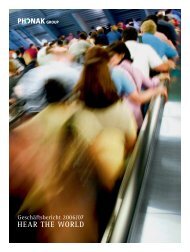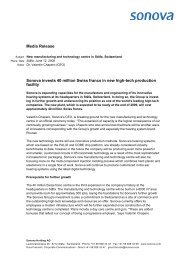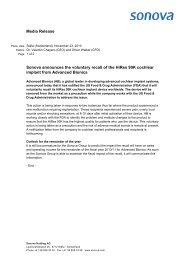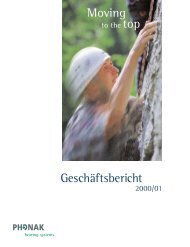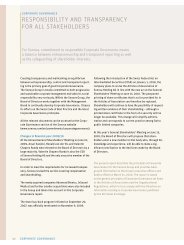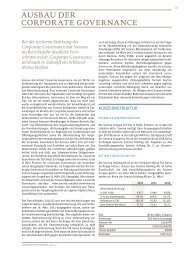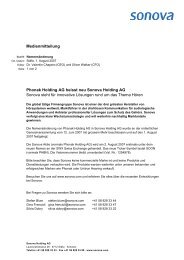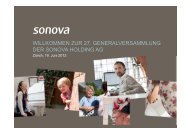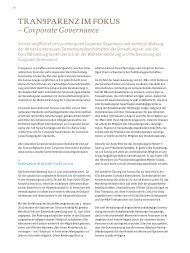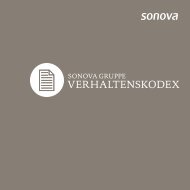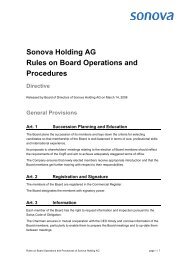Annual Report 2010/11 - Sonova
Annual Report 2010/11 - Sonova
Annual Report 2010/11 - Sonova
Create successful ePaper yourself
Turn your PDF publications into a flip-book with our unique Google optimized e-Paper software.
oTHeR CuRReNT FINANCIAL ASSeTS<br />
other current financial assets consist of financial assets<br />
held for trading. Marketable securities within this category<br />
are classified as financial assets at fair value through<br />
profit or loss (see Note 3.4). derivatives are classified as<br />
held for trading unless they are designated as hedges<br />
(see Note 3.5).<br />
TRAde ReCeIvABLeS<br />
Trade receivables are recorded at original invoice amount<br />
less provision made for doubtful accounts. A provision for<br />
doubtful accounts is recorded when there is objective evidence<br />
that the Group will not be able to collect all amounts<br />
due according to the original terms of the invoice. The<br />
amount of the provision is the difference between the carrying<br />
amount and the recoverable amount, being the present<br />
value of expected cash flows.<br />
INveNToRIeS<br />
Purchased raw materials, components and finished goods<br />
are valued at the lower of cost or net re alizable value. To<br />
evaluate cost, the standard cost method is applied, which<br />
approximates historical cost determined on a firstin firstout<br />
basis. Stan dard costs take into account normal levels of<br />
materials, supplies, labor, efficiency, and capacity utilization.<br />
Standard costs are regularly reviewed and, if necessary,<br />
revised in the light of current conditions. Net realizable<br />
value is the estimated selling price in the ordinary course<br />
of business less the estimated costs of completion (where<br />
appli cable) and selling expenses. Manufactured finished<br />
goods and workinprocess are valued at the lower of<br />
production cost or net realizable value. Provisions are<br />
established for slowmoving, obsolete and phaseout<br />
inventory.<br />
PRoPeRTy, PLANT ANd equIPMeNT<br />
CoNSoLIdATed FINANCIAL STATeMeNTS<br />
Property, plant and equipment is valued at purchase or<br />
manufacturing cost less accumulated depre ciation and any<br />
impairment in value. depreciation is calculated on a<br />
straightline basis over the ex pected useful lives of the<br />
individual assets or asset categories. Where an asset<br />
comprises several parts with different useful lives, each<br />
part of the asset is depreciated separately over its applicable<br />
useful life. The applicable useful lives are 25–40 years<br />
for buildings and 3–10 years for production facilities,<br />
machinery, equipment, and vehicles. Land is not depreciated.<br />
Leasehold improvements are depreciated over the<br />
shorter of useful life or lease term.<br />
Borrowing costs incurred for the construction of any qualifying<br />
asset are capitalized during the period of time that is<br />
required to complete and prepare the asset for its intended<br />
use. Subsequent expenditure on an item of tangible assets<br />
is capitalized at cost only when it is probable that future<br />
economic benefits associated with the item will flow to the<br />
Group and the cost of the item can be measured reli ably.<br />
expenditures for repair and maintenance which do not in<br />
crease the estimated useful lives of the related assets<br />
are recognized as an expense in the period in which they<br />
are incurred.<br />
ReSeARCH ANd deveLoPMeNT<br />
Research costs are expensed as incurred. development<br />
costs are capitalized only if the identifiable asset is commercially<br />
and technically feasible, can be completed, its costs<br />
can be measured reliably and will generate probable future<br />
economic benefits. Group expenditures which fulfill these<br />
criteria are limited to the development of tooling and equipment<br />
as well as costs relating to the development of hearing<br />
implants. All other development costs are expensed as<br />
incurred. In addition to the internal costs (direct personnel<br />
and other operating costs, de preciation on research and<br />
development equipment and allocated occupancy costs),<br />
total costs also include externally contracted development<br />
work. Such capitalized intangibles are recognized at cost<br />
less accumulated amortization and impairment losses.<br />
Amortization starts when the capitalized as set is ready for<br />
use. These assets are generally amortized over the estimated<br />
useful life applying the straightline method. Capitalized<br />
in progress development costs are tested for impairment<br />
annually.<br />
99



